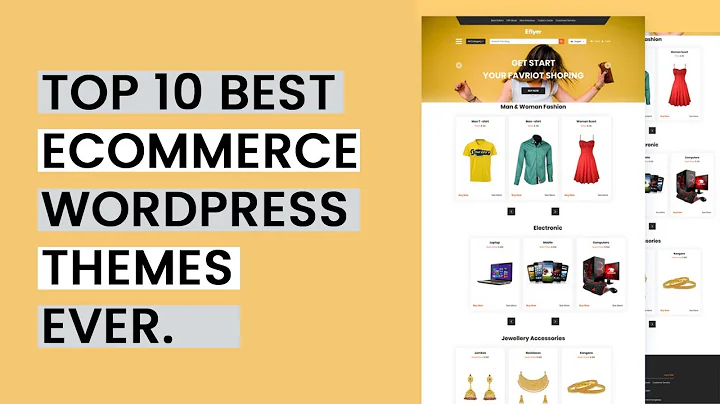Mastering Google Ads: A Comprehensive Guide to Success
Table of Contents
- Introduction
- Understanding Google Ads
- The Power of Google Ads
- Overcoming the Complexity
- The Importance of Understanding
- The Four Categories of Google Ads
- Search Ads
- Text Ads
- Shopping Ads
- Branded and Non-Branded Searches
- Dynamic Search Ads
- The Beginner-Friendly Ad Type
- Relying on Google's Site Scrapers
- The Relevance and Cost
- Google Smart Shopping Ads
- Recommended for Beginners
- Leveraging Google's Machine Learning Algorithms
- The Three Types of Ads
- Display Ads
- Introduction to Display Ads
- Topic and Interest Ads
- Managed Placements Ads
- Video Ads
- The Importance of YouTube
- In-Feed Video Ads
- In-Stream Video Ads
- Bumper Ads
- Retargeting or Remarketing Ads
- Conclusion
Understanding Google Ads
Google Ads is a powerful platform for reaching audiences effectively. While social media platforms like Facebook and Instagram might seem like the go-to places to invest in ad dollars, Google Ads still holds the top spot in terms of reach and effectiveness. However, many small business owners find Google Ads to be complicated and daunting. In this article, we will break down the 10 different types of Google Ads that you can run as a small business owner. By understanding each ad type, you can make informed decisions on which ones are best suited for your business goals. Whether you are new to Google Ads or looking to optimize your ad dollars, this article will provide valuable insights and guidance.
Search Ads
Search ads are the most common type of ads on Google. These ads appear in various contexts when people type something into the Google search bar. There are two main categories of search ads: text ads and shopping ads.
Text ads appear at the top of search results pages and are a popular choice for businesses looking to drive conversions. Shopping ads, on the other hand, depend on whether the search terms yield enough results for items for sale. Within search ads, there are also branded and non-branded searches. Branded searches involve users specifically searching for a brand, while non-branded searches involve users searching for a product or service without a specific brand in mind.
The goal of search ads is to create a three-way relationship between the user's search, the relevance of keywords you bid on, and the ad type you select to display. While the concept may seem confusing at first, we will explore each ad type in more detail to help you understand their nuances and effectiveness.
Text Ads
Text ads are the most common type of search ads that you will come across on Google. These ads appear at the top of search results pages and are tailored to match the user's search queries. For businesses, text ads are a great way to drive conversions as they appear at the most relevant moment when users are actively searching for products or services.
Branded and non-branded searches play a significant role in text ads. Branded searches occur when users specifically search for a brand, such as "Nike sneakers for women." These searches indicate a high degree of relevance as users are actively seeking out a particular brand. On the other hand, non-branded searches involve users searching for a product or service without specifying a brand, such as "sneakers for women." While the relevance may be slightly lower in non-branded searches, they provide an opportunity for businesses to capture potential customers who are in the market for their offerings.
The cost per click for text ads can vary depending on factors such as industry and competition. On average, the cost per click ranges between 25 cents and $4. Text ads are recommended for businesses of all sizes as they offer high relevance and the potential for conversions. However, setting up text ads requires some knowledge and expertise, particularly in understanding concepts like negative keywords.
Shopping Ads
Shopping ads are designed specifically for e-commerce businesses that sell products online. These ads appear when users search for products that are available for purchase. The main distinction between text ads and shopping ads is that shopping ads showcase product information, such as images, prices, and ratings, directly in the search results.
Google determines when to display shopping ads based on the search terms and the availability of products for sale. When a user searches for a specific product, Google matches the search query with relevant products and displays the corresponding shopping ads. This type of ad is highly effective for businesses focused on driving online sales.
Branded and non-branded searches also come into play in shopping ads. Branded searches occur when users search for a specific brand, such as "Nike sneakers for women." In contrast, non-branded searches involve generic queries like "sneakers for women." By targeting both branded and non-branded searches, businesses can capture a wider audience and increase their chances of conversions.
The cost per click for shopping ads varies depending on factors such as competition and bid strategy. On average, the cost per click for shopping ads can range from 25 cents to $4. Shopping ads are recommended for e-commerce businesses looking to showcase their products and drive online sales. However, setting up shopping ads requires some expertise in creating product feeds and optimizing campaigns for maximum visibility and profitability.
Branded and Non-Branded Searches
Branded and non-branded searches play a crucial role in search ads. Branded searches occur when users specifically search for a particular brand, such as "Nike sneakers for women." These searches are highly relevant as users are actively seeking out a specific brand. For businesses, running branded search ads allows them to capture potential customers who are already familiar with their brand and increase the likelihood of conversions.
Non-branded searches, on the other hand, involve users searching for a product or service without specifying a brand. For example, a user may search for "sneakers for women" without including a specific brand name. While the relevance may be slightly lower in non-branded searches, they present an opportunity for businesses to showcase their offerings to users who are actively seeking products or services within a specific category.
When it comes to running search ads, businesses need to consider the relevance of keywords and the intent behind the user's search. By understanding the nuances of branded and non-branded searches, businesses can tailor their ad campaigns to target the right audience effectively.
Although branded search ads have a high degree of relevance, the setup and implementation can be more complex compared to non-branded search ads. Businesses need to take into account factors such as negative keywords and ensure that their ad campaigns are highly targeted and focused on capturing potential customers who are searching specifically for their brand.
Non-branded search ads, on the other hand, can be a more cost-effective option for businesses operating on a tighter budget. The cost per click for non-branded search ads may be higher than branded search ads, but businesses can still reach a broader audience and increase their chances of conversions.
In summary, both branded and non-branded search ads offer unique advantages for businesses. Branded search ads allow businesses to capitalize on customers actively searching for their brand, while non-branded search ads provide an opportunity to reach a wider audience and maximize visibility. The choice between branded and non-branded search ads depends on factors such as budget, brand recognition, and specific campaign goals. By understanding the differences between these two types of search ads, businesses can make informed decisions and optimize their ad spend effectively.
Dynamic Search Ads
Dynamic Search Ads are a beginner-friendly ad type that leverages Google's site scrapers to generate keywords and serve ads based on the content of your website. With Dynamic Search Ads, you don't have to define specific keywords or create ads manually. Instead, Google analyzes your website's content and displays relevant ads to users based on their search queries.
The goal of Dynamic Search Ads is to automate the ad creation and targeting process, making it easier for beginners to get started with Google Ads. By relying on Google's machine learning algorithms, Dynamic Search Ads can generate ads based on the specific products or services mentioned on your website. This allows businesses to reach potential customers who are actively searching for offerings related to their website content.
The relevance of Dynamic Search Ads depends on how well-refined and niched down your website's content is. If your website content is focused and closely aligned with your products or services, Dynamic Search Ads can be highly effective in reaching a targeted audience. However, if your website's content is too broad or diverse, Google may have difficulty targeting the right audience for your ads.
The cost per click for Dynamic Search Ads can range from 2 cents to $6, depending on factors such as industry and competition. Despite the potential for a higher cost per click, Dynamic Search Ads offer an easy and efficient way for beginners to run search-based ad campaigns without the need for extensive keyword research or ad creation.
It's important to note that while Dynamic Search Ads provide a quick and easy way to get started with search-based ads, businesses should still invest time and effort in tracking results and campaign analytics. By analyzing the performance of Dynamic Search Ads, businesses can gain valuable insights and learn to develop more customized and optimized search campaigns in the future.
In conclusion, Dynamic Search Ads offer a simplified approach to running search-based ad campaigns. With the power of Google's machine learning algorithms, businesses can automate the ad creation process and target potential customers based on the content of their website. While their relevance may depend on the specificity of website content, Dynamic Search Ads provide an excellent baseline for beginners to learn and optimize their ad dollars in the future.






















